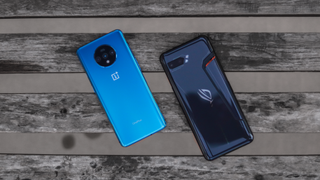OnePlus 7T vs ASUS ROG Phone 2: Best phones under Rs 40,000 compared
The closest one yet.
Batter and charging

With all that performance and speed, you’d want your phone to last for a while. Battery life on smartphones these days is generally good, and there’s always fast charging to make up for when the battery life isn’t.
Once again, we see them opt for very different routes with battery sizes and refueling. The OnePlus 7T ships with a 3,800 mAh battery, which is suitable for a day of mixed usage involving an hour or so gaming, social media, push notifications and calls with wifi or data on throughout. Nothing exceptional, and unlikely to last you to the second day.
ASUS went with a bigger battery at the expense of slimness, managing to fit in a 6,000 mAh battery which is the biggest on any mainstream device currently, and the battery life is just bonkers. It’s almost guaranteed to last you two days on a single charge with moderate usage. If you want to push the gaming bit to its limit, the ROG Phone 2 will still not give up. In our testing, we were able to touch 7 hours of continuous PUBG Mobile at the max framerate of 60fps. For context, that’s how much screen-on-time a regular phone would give in a day of light to moderate use.
Expectedly, the tip of the table in favor of OnePlus when it comes to charging. The new Warp Charge 30T can charge to phone from 0 to full in less than an hour, with a 30 minute top up refilling about 60% of the battery. It doesn’t slow down all that much during gaming.
This base variant of the ASUS ROG Phone 2 ships with an 18W fast charger in the box, which takes about 2 hours to charge the phone from empty. Not bad, considering that the battery is so big, but pales in comparison with Warp Charge.
The clear winner over here is the ROG Phone 2, with its two-day battery life. If the charging speeds worry you, the faster 30W “Hypercharger” can be yours for just Rs 1,999.
Camera
Smartphone photography is essential, and with the onslaught of multiple lenses at varying focal lengths, it’s only got closer to replacing point-and-shoot cameras. Heading into this round, we knew we had to have our expectations in control as gaming phones have historically not been great at photography.
Get daily insight, inspiration and deals in your inbox
Get the hottest deals available in your inbox plus news, reviews, opinion, analysis and more from the TechRadar team.
The OnePlus 7T has triple-camera setup on the back, consisting of a 48MP f/1.6 primary camera with OIS, a 16MP ultra-wide shooter with an f/2.2 aperture and a third 12MP telephoto lens with a 2x optical zoom.
The ASUS ROG Phone 2 has a dual-camera setup with the same 48MP primary sensor with an f/1.8 aperture along with a 13MP ultrawide shooter at f/2.4.

Regular


Ultrawide






Night mode

As expected, the OnePlus 7T captures better-looking shots in most of the images, thanks to the superior hardware combined with image processing. In most cases, the ROG Phone 2 gave a slightly cooler image, but even the saturation and contrast were a little lacking.
Verdict

You might have noticed by now how different these two phones are, with similarities ending at the spec sheet. As we mentioned earlier, these phones aren’t meant for the same type of consumer, and both address vastly different preferences.
The OnePlus 7T is the right phone for those who want a phone that works well needs minimum tweaking and performs admirably in all departments. The display and the camera are significant strengths, along with one of the most refined software experiences.
The ASUS ROG Phone 2 is the best a gamer can get, with a big display, an astounding pair of speakers and battery life to keep you going. The ROG UI offers a lot of customization and monitoring while gaming but can feel a little overwhelming to some.
OnePlus has always been one of the first ones to bring the latest software version updates to the market, and the 7T is the first phone to run Android 10 out-of-the-box. Not just that, regular updates are also guaranteed to arrive in a timely fashion, increasing the overall UX of the phone with time.
It is ASUS’ only second attempt with a gaming flagship, with the first one being forgotten quickly. Software updates have also not been as timely or frequent, not just in comparison to OnePlus, but also according to industry standards.
The OnePlus 7T is bound to outsell the ROG Phone 2 manifold, which also means you will get better third-party support for repairs, services, and accessories. ASUS’ service network isn’t nearly as robust as OnePlus’, which is a factor to consider when you are about to drop 40K on the phone.
In simpler words, the 7T is better positioned to stay relevant for a more extended period and might improve over time too. ASUS’ effort with the ROG Phone 2 is commendable. It’s not often we see surprise devices get launched and steal the thunder from the latest OnePlus flagships. If they can continue this trajectory and prove that they are here for the long term, the next ROG Phone will get a much more confident recommendation.
Current page: Battery and Charging, Camera, Verdict
Prev Page Audio, Performance, Gaming, Software and FeaturesAakash is the engine that keeps TechRadar India running, using his experience and ideas to help consumers get to the right products via reviews, buying guides and explainers. Apart from phones, computers and cameras, he is obsessed with electric vehicles.
Most Popular

